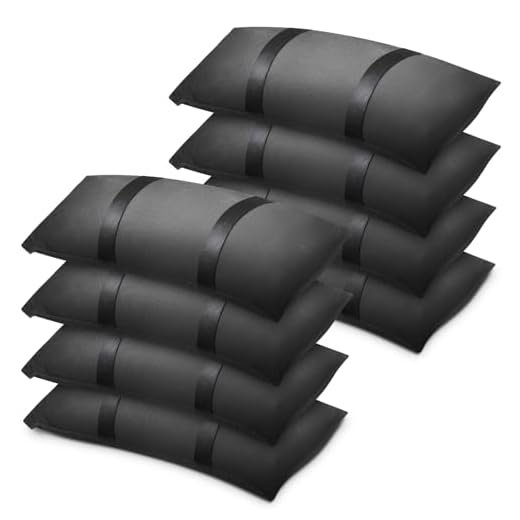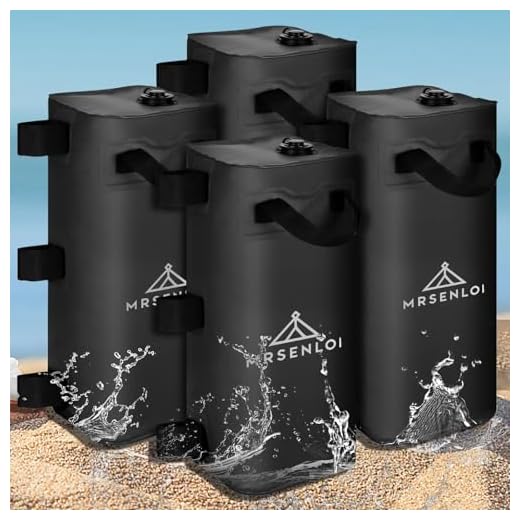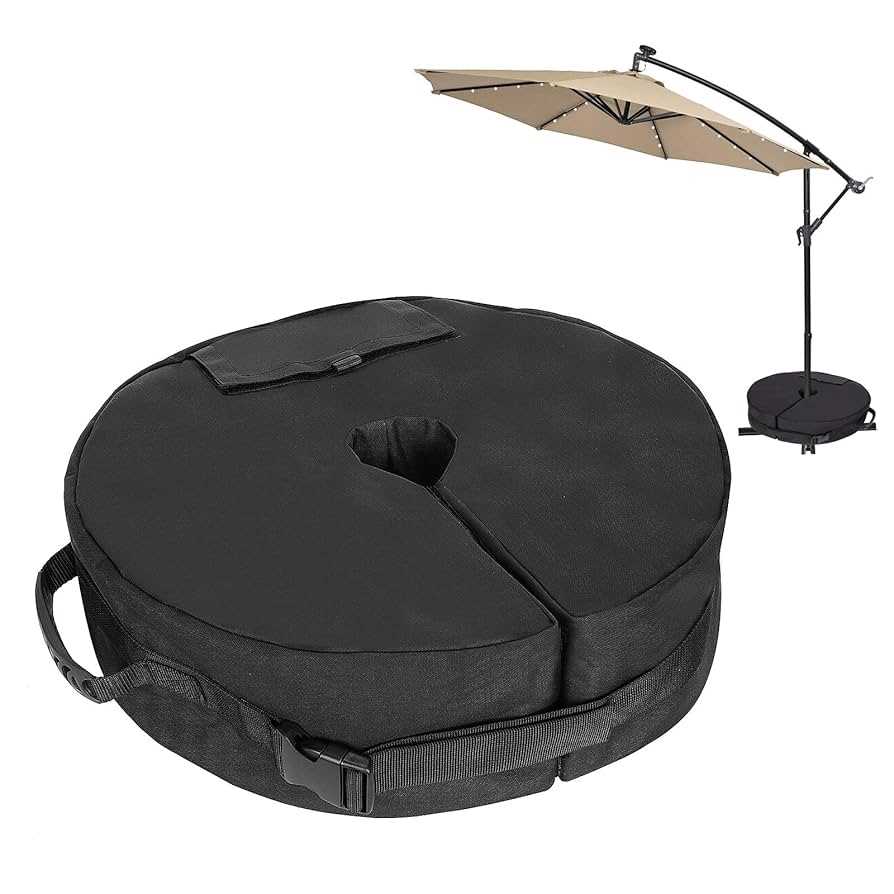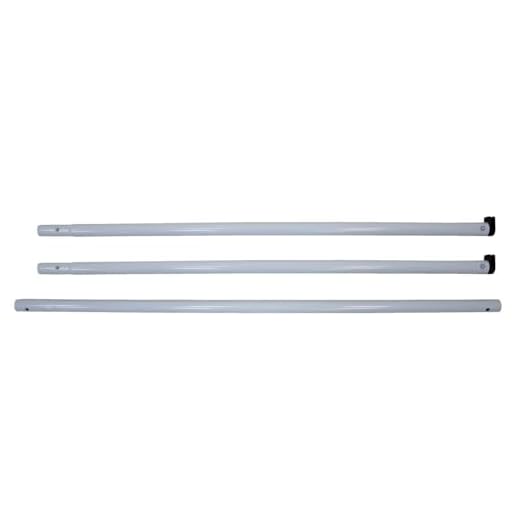




For maximum stability, a minimum of 20 pounds is recommended for securing your canopies during breezy conditions. This article provides insights into various options for achieving that stability, including weighted bases, sandbags, and water-filled solutions.
This information is tailored for event planners, outdoor enthusiasts, and anyone seeking reliable protection from the elements. It offers practical suggestions and alternatives that can enhance the durability of your setups.
Throughout the text, you’ll find a comparison of different securing methods, highlighting their advantages and drawbacks. By the end, you’ll be equipped with the knowledge to choose the most suitable option, ensuring your canopies remain upright and functional in varying weather scenarios.
Best Weight Use to Hold Down Umbrellas
A minimum of 20 pounds is recommended for securing a typical outdoor canopy. This amount helps prevent tipping during moderate winds, ensuring stability and safety. For larger structures, consider increasing the mass to 30-50 pounds, depending on the size and design.
Materials play a significant role in the effectiveness of securing devices. Heavy-duty plastic, concrete, or metal bases provide the best performance. Choosing a design that allows for easy transport and storage is also beneficial for convenience.
Factors to Consider
- Wind Conditions: Assess the average wind speed in your area. Stronger winds require heavier support.
- Size of the Canopy: Larger canopies need more substantial support to maintain stability.
- Surface Type: Ensure the base can grip various surfaces, such as grass, sand, or concrete.
Incorporating additional weights, such as sandbags or water-filled containers, can enhance security. These options are versatile and can be adjusted based on conditions. Always ensure that the total mass is evenly distributed for optimal performance.
| Condition | Recommended Mass |
|---|---|
| Calm Weather | 20-30 pounds |
| Moderate Winds | 30-50 pounds |
| Strong Winds | 50+ pounds |
For added safety, regularly check the stability of the set-up and make adjustments as needed. A proactive approach ensures longevity and reliability in various weather conditions.
Choosing the Right Material for Umbrella Weights
For securing outdoor canopies, selecting the appropriate material is fundamental. Options such as concrete, plastic, and metal each have distinct characteristics that impact performance and usability.
Concrete offers durability and stability, making it a reliable choice. It can withstand strong winds and is less likely to shift compared to lighter alternatives. However, its weight can make transportation cumbersome.
Material Comparison
| Material | Advantages | Disadvantages |
|---|---|---|
| Concrete | High stability, long-lasting | Heavy, difficult to move |
| Plastic | Lightweight, easy to transport | Less stable, may not withstand strong winds |
| Metal | Durable, resistant to corrosion | Can be heavy, may require maintenance |
Plastic materials can be molded into various shapes, providing versatility in design. While they are easier to handle, their lighter nature may not offer the same level of resistance in adverse weather conditions.
Metal options, such as steel or aluminum, combine strength with a relatively manageable weight. They often resist corrosion, ensuring longevity. Consider the environment where the canopy will be used to choose a material that aligns with your needs.
Optimal Weight Distribution for Stability in Windy Conditions
For ensuring stability during breezy weather, a balanced approach to anchoring is paramount. The distribution of mass should be tailored to counteract the forces of wind effectively. A lower center of gravity contributes significantly to preventing tipping, while a wider base enhances resistance against lateral movements.
Strategically placing heavier elements around the base creates a solid foundation. Utilizing materials such as sand or water for ballast can be particularly advantageous, as these substances provide weight while being adaptable to different environments. Consider the following aspects:
Key Factors for Stability
- Center of Gravity: A lower center minimizes the risk of overturning.
- Base Width: A wider base increases stability against lateral forces.
- Material Selection: Heavy, dense materials offer better anchoring capabilities.
- Distribution: Evenly spread weight prevents uneven stress that may lead to failure.
When positioning, ensure that heavier components are closer to the ground. This configuration reduces the likelihood of tilting due to wind uplift. Additionally, incorporating a design that allows for quick adjustment of the anchoring elements can provide flexibility in response to changing wind conditions.
| Material | Weight (per unit) | Effectiveness |
|---|---|---|
| Sand | Heavy | High |
| Water | Moderate | Medium |
| Bricks | Very Heavy | Very High |
By focusing on these principles, one can significantly enhance the stability of structures exposed to windy conditions, ensuring they remain functional and secure.
Portable vs. Permanent Options for Umbrella Stability
Choosing between portable and permanent solutions for securing canopies requires careful thought. Portable options offer flexibility, making them ideal for casual settings, while permanent solutions provide robust stability for long-term use.
Portable methods typically include weights that can be easily moved and adjusted. These may consist of sandbags, water-filled bases, or other materials that provide sufficient grounding during windy conditions. The advantage of this approach lies in its convenience, as users can transport these items without hassle, adapting to various environments.
Permanent Solutions
On the other hand, permanent installations involve more permanent fixtures such as concrete bases or in-ground mounts. These systems are designed to remain stationary, providing a high level of support against strong winds and adverse weather. While they require more effort to install, their durability often outweighs the initial commitment.
When deciding between these two options, consider factors like frequency of use, environmental conditions, and installation effort. Each method has unique benefits and limitations that cater to different needs and preferences.
- Portable: Easily movable, adjustable, suitable for temporary setups.
- Permanent: Highly stable, requires installation, ideal for long-term applications.
Ultimately, the choice depends on individual circumstances and priorities. Evaluate your specific requirements to select the most appropriate solution for maintaining stability in your outdoor spaces.
DIY Solutions for Effective Umbrella Ballasting
Utilizing sandbags is a practical method to stabilize outdoor canopies. Fill durable bags with sand, tying them securely to prevent spillage. Position these bags around the base of the structure for enhanced stability against gusts of wind.
Another innovative approach involves using water-filled containers. Large plastic bottles or jugs can be repurposed for this task. Simply fill them with water, seal, and place them at the base. This method provides a convenient and adjustable solution, allowing for easy transport and storage when not in use.
Additional Creative Options
- Concrete Blocks: These can be stacked around the base to add significant mass. Ensure they are stable and securely placed to prevent shifting.
- Weighted Tarps: Employing tarps with pockets can allow for adding rocks or other heavy materials directly into the tarp. This aids in anchoring the structure firmly against the wind.
- Hollowed Out Logs: If available, hollowed logs can be filled with stones or sand, creating a natural and rustic ballast that blends with outdoor environments.
When selecting materials, consider their availability and weight. The goal is to achieve a balance between portability and stability. Regularly inspect your setups to ensure they remain secure and functional, particularly after stormy weather.
Conclusion on Commercial Canopy Stabilizers
For those seeking reliable solutions to secure outdoor canopies, options such as sandbags, concrete bases, and water-filled models prove to be highly effective. Each type offers unique advantages depending on environmental conditions and specific needs.
The review indicates that concrete bases generally provide superior stability, making them ideal for windy areas. Conversely, portable water-filled versions are convenient for mobility and storage. Sandbags serve as a versatile option, easily adjustable to various settings.
Recommendations:
- Concrete Bases: Opt for these in areas prone to high winds.
- Water-Filled Options: Ideal for temporary setups and easy transport.
- Sandbags: A flexible choice that can be adapted to different environments.
Assessing personal requirements and environmental factors will guide the best selection for securing canopies effectively.
Best weight use to hold down umbrellas
Features
| Part Number | FUB41B |
| Model | FUB41B |
| Color | Black |
| Release Date | 2023-12-22T00:00:01Z |
Features
| Part Number | BLUS-15 |
| Model | BLUS-15 |
| Color | Black |
| Size | 8 X 50 lbs |
Features
| Part Number | / |
| Model | / |
| Color | Black-25L |
Features
| Part Number | SKY5897 |
| Model | SKY5897 |
| Color | Black |
| Size | Set of 1 |
Features
| Part Number | 8003 |
| Model | 8003 |
| Color | Black |
| Size | Large |
Features
| Part Number | SD-240166 |
| Model | 240166 |
| Color | Custom |
Video:
FAQ:
What is the ideal weight for an umbrella base to ensure stability in windy conditions?
The ideal weight for an umbrella base depends on the size and type of the umbrella. Generally, for a standard patio umbrella (around 7.5 to 9 feet in diameter), a base weighing between 50 to 70 pounds is recommended. This weight helps to keep the umbrella stable during moderate winds. For larger umbrellas (10 feet or more), a base weighing 80 to 100 pounds may be necessary to prevent tipping or blowing over. It’s also important to consider the material of the base; concrete or heavy-duty plastic filled with sand or water can provide better stability than lighter materials.
How can I securely hold down my umbrella without a heavy base?
If you don’t have a heavy base, there are several alternatives to secure your umbrella. One option is to fill a durable bag or container with sand, gravel, or water and attach it to the umbrella pole. You can also use weights such as bricks or stones around the base of the umbrella. Another idea is to anchor the umbrella by attaching it to a stable patio or deck structure with straps or bungee cords. However, these methods may not provide the same level of stability as a heavy base, so it’s best to monitor the umbrella closely in windy conditions and take it down if necessary.









